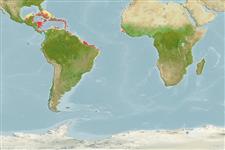Common names from other countries
Environment: milieu / climate zone / depth range / distribution range
Ecología
marino asociado a arrecife; rango de profundidad 5 - 40 m (Ref. 13121). Tropical
Western Atlantic: Nicaragua, Belize and the Caribbean islands to Atol das Rocas, Brazil (Ref. 57756). Eastern Central Atlantic: St. Paul's Rocks (Ref. 13121).
Tamaño / Peso / Age
Maturity: Lm ? range ? - ? cm
Max length : 2.8 cm SL macho / no sexado; (Ref. 13121)
Espinas dorsales (total) : 18 - 19; Radios blandos dorsales (total) : 7 - 9; Espinas anales: 2; Radios blandos anales: 15 - 17; Vértebra: 31 - 33.
Found in crevices and on rubble to depths of at least 40 m (Ref. 13121).
Life cycle and mating behavior
Maturities | Reproducción | Spawnings | Egg(s) | Fecundities | Larva
Wiliams, J.T. and J.H. Mounts, 2003. Descriptions of six new Caribbean fish species in the genus Starksia (Labrisomidae). aqua, J. Ichthyol. Aquat. Biol. 6(4):145-164. (Ref. 50108)
IUCN Red List Status (Ref. 130435)
CITES (Ref. 128078)
Not Evaluated
Threat to humans
Harmless
Human uses
Herramientas
Special reports
Download XML
Fuentes de Internet
Estimates based on models
Preferred temperature (Ref.
115969): 26.8 - 28.1, mean 27.5 (based on 106 cells).
Phylogenetic diversity index (Ref.
82804): PD
50 = 0.5000 [Uniqueness, from 0.5 = low to 2.0 = high].
Bayesian length-weight: a=0.01000 (0.00244 - 0.04107), b=3.04 (2.81 - 3.27), in cm Total Length, based on all LWR estimates for this body shape (Ref.
93245).
Nivel trófico (Ref.
69278): 3.3 ±0.4 se; based on size and trophs of closest relatives
Fishing Vulnerability (Ref.
59153): Low vulnerability (10 of 100).
